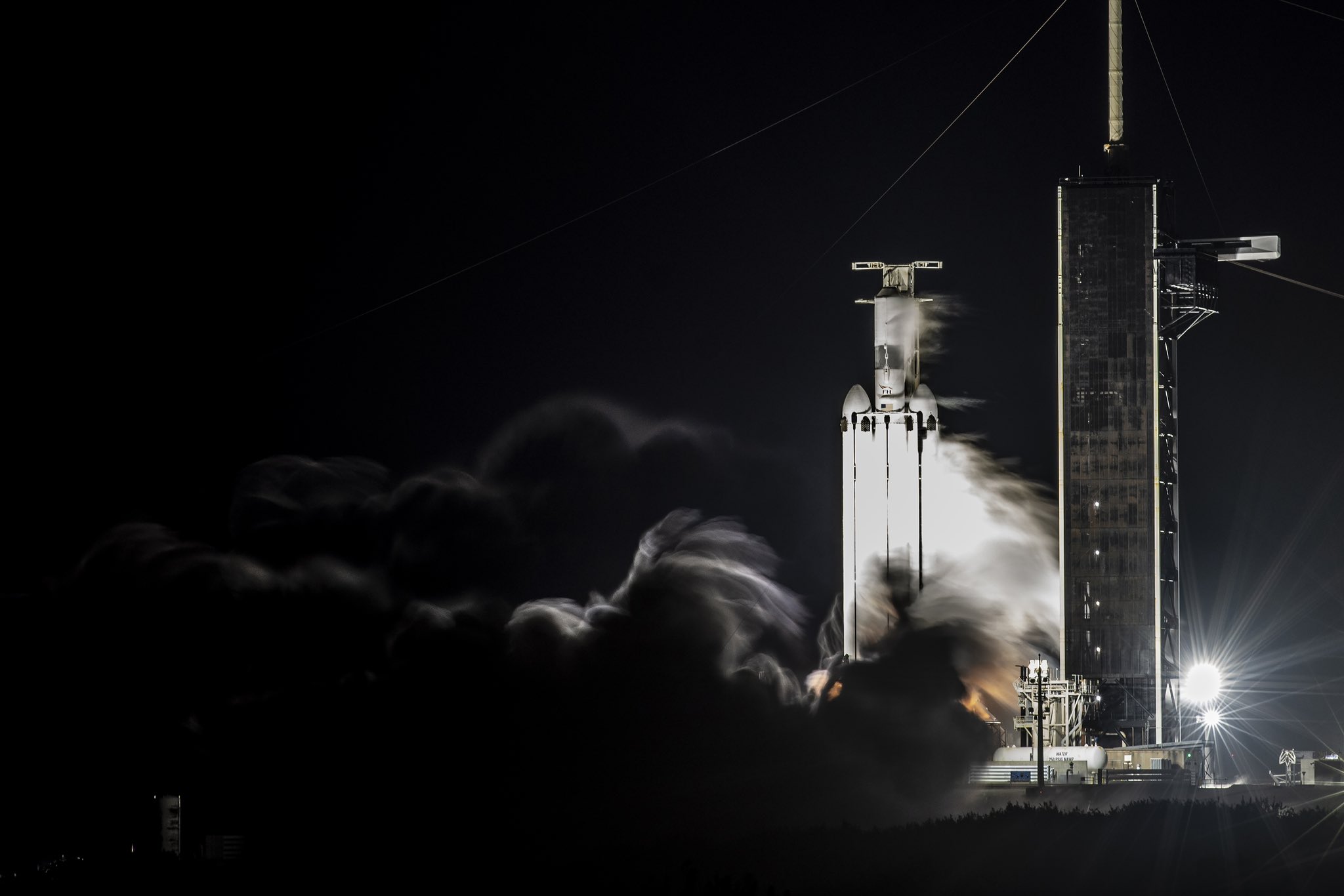Space News & Blog Articles
SpaceX’s Falcon Heavy test-fired on launch pad in Florida
 SpaceX’s Falcon Heavy rocket fires its 27 main engines Thursday night at Kennedy Space Center in Florida. Credit: SpaceX
SpaceX’s Falcon Heavy rocket fires its 27 main engines Thursday night at Kennedy Space Center in Florida. Credit: SpaceX
SpaceX fired up 27 engines on a Falcon Heavy rocket Thursday night at Kennedy Space Center, sending a rumble across the spaceport in a hold-down test-firing before a launch next week for the U.S. Space Force.
The 27 Merlin engines ignited at 8 p.m. EDT Thursday (0000 GMT Friday) and ran for nearly 10 seconds. SpaceX’s launch team loaded about three million pounds of kerosene and liquid oxygen propellants into the Falcon Heavy during the final hour of the countdown before the static fire test.
A plume of exhaust rushed out of the north side of the flame trench at Launch Complex 39A, and the static fire test generated a window-rattling roar heard for miles around. The engines briefly throttled up to full power, producing 5.1 million pounds of thrust, before shutting down to conclude the test-firing. SpaceX drained propellants from the rocket and planned to lower it horizontal and return it to the hangar a quarter-mile south of pad 39A for integration with its Space Force payloads.
SpaceX conducted the static fire test Thursday night without the payloads or payload fairing on the Falcon Heavy rocket. Those elements were prepared at a separate satellite processing facility at the spaceport.
Launch of the USSF 44 mission is set for 9:40 a.m. EDT (1340 GMT) Tuesday.
The Falcon Heavy is the world’s most powerful operational rocket, and next week’s launch will be the fourth flight of the heavy-lifter since its debut in 2018. The first test flight of a Falcon Heavy rocket sent a Tesla Roadster on an Earth escape trajectory into a heliocentric orbit. Two missions in April 2019 and June 2019 delivered to orbit a commercial communications satellite for Arabsat and a cluster of small experimental satellites for the U.S. military and NASA.
A lack of ready payloads has delayed several Falcon Heavy missions the last few years, including the mission set for liftoff next week. This mission, designated USSF 44, will carry multiple satellites into a geosynchronous orbit for the Space Force, targeting a deployment altitude more than 20,000 miles over the equator.
The mission will require a long coast of roughly six hours between burns by the Falcon Heavy’s upper stage, making it the longest duration SpaceX rocket mission from launch until payload deployment. SpaceX added gray paint around the kerosene fuel tank on the upper stage to provide thermal insulation and keep the fuel from freezing during the long coast through the cold vacuum of space.
Despite the break in Falcon Heavy launches since 2019, SpaceX has continued to win contracts to build its backlog of Falcon Heavy missions, which offer payload lift capability greater than the Falcon 9 but below that of the company’s next-generation Starship and Super Heavy rocket. The Falcon Heavy is powered by 27 Merlin main engines from three Falcon rocket cores connected together, and stands 229 feet (70 meters) tall and 40 feet (12.2 meters) wide.
The Falcon Heavy’s upper stage is mostly identical to the upper stage of a Falcon 9 rocket, with a single Merlin engine.
SpaceX says the Falcon Heavy rocket is capable of placing a payload of up to 140,000 pounds, or more than 63 metric tons, into a low-altitude orbit. That figure assumes the Falcon Heavy’s boosters are burned to near fuel depletion and not recovered.
For the USSF 44 mission, SpaceX aims to land the Falcon Heavy’s side boosters back at Cape Canaveral Space Force Station less than 10 minutes after liftoff. The center core will devote all of its propellant to sending the Space Force payloads into orbit, and will not be recovered.
SpaceX’s most recent Falcon Heavy launch contract win was in July, when NASA awarded the company a deal worth $255 million to launch the Nancy Grace Roman Space Telescope in 2026.
With the Roman launch contract in hand, SpaceX now has a backlog of up to 13 Falcon Heavy rocket missions.
This email address is being protected from spambots. You need JavaScript enabled to view it. the author.
Follow Stephen Clark on Twitter: @StephenClark1.
When you subscribe to the SpaceZE News Feed, we will send you an e-mail when there are new updates on the site so you wouldn't miss them.

